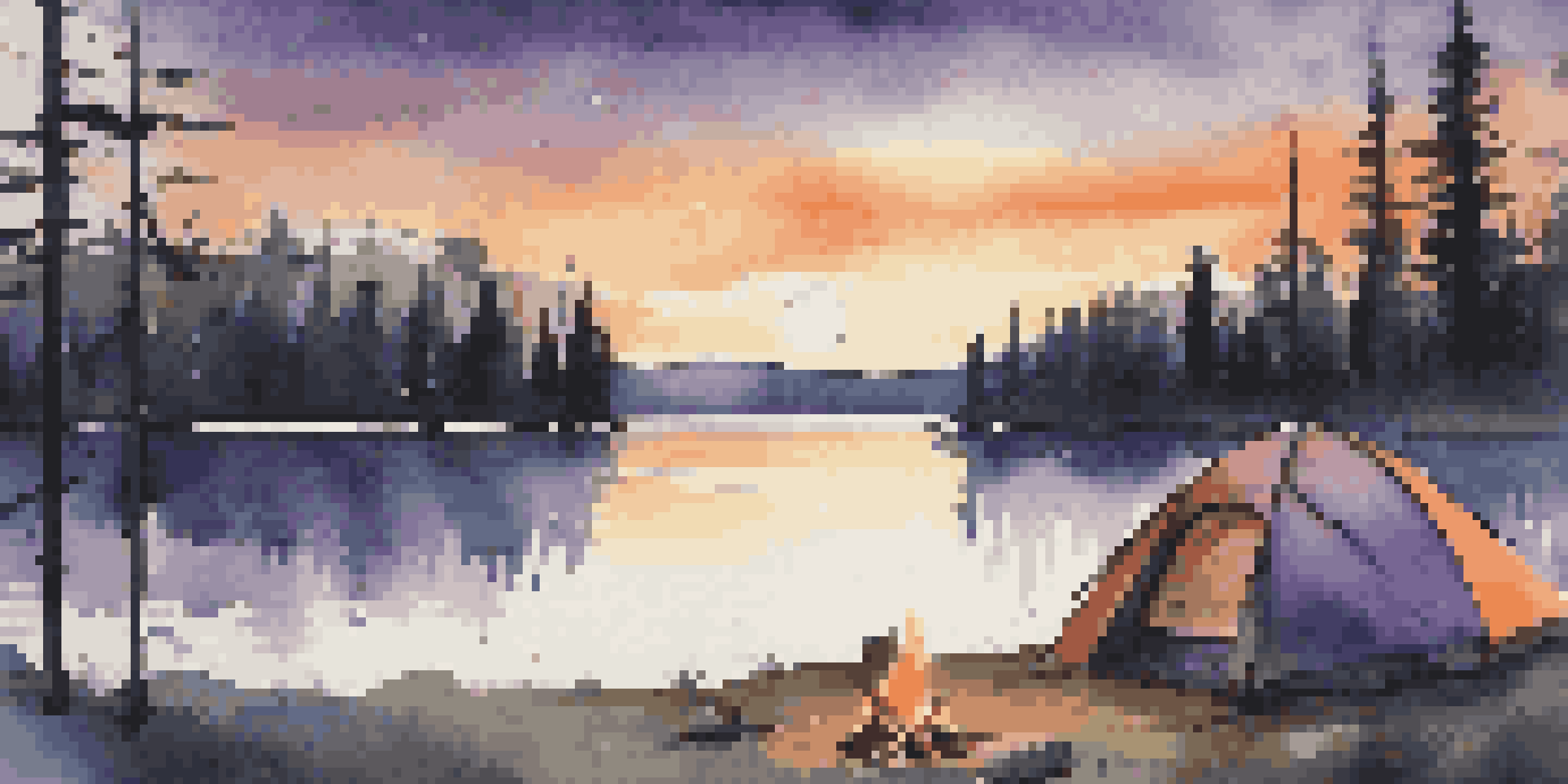Understanding Weather Patterns: Plan Your Camping Trip

Why Weather Patterns Matter for Camping Trips
Understanding weather patterns is crucial for campers. The right conditions can make a trip enjoyable, while unexpected weather can lead to discomfort or danger. Whether you're a seasoned camper or a newbie, knowing how to read the signs can enhance your outdoor experience.
The weather is like the government, always in the wrong.
For instance, a sunny forecast might encourage you to pack lighter clothing, while a chance of rain might prompt you to bring waterproof gear. Weather can change rapidly, especially in mountainous regions, so being prepared is essential. By paying attention to weather patterns, you can ensure your safety and comfort.
Additionally, understanding how weather influences your camping location can help you choose the best time to visit. Different seasons bring unique weather phenomena, allowing you to plan around the best conditions, be it for hiking, fishing, or simply enjoying nature.
Decoding Weather Forecasts: What to Look For
Weather forecasts are your best friend when planning a camping trip. They provide essential information like temperature, precipitation, and wind speed, which are all critical for outdoor activities. However, not all forecasts are created equal, so knowing how to interpret them is key.

Start by checking reliable sources, such as national weather services or dedicated weather apps. Look for specific details, like hourly forecasts, which can give you a clearer picture of what to expect during your trip. This way, you can avoid being caught in unexpected downpours or chilly nights.
Understand Weather for Safe Camping
Knowing weather patterns enhances safety and comfort during your camping trips.
Moreover, keep an eye on weather alerts. These warnings can inform you of severe weather that could disrupt your camping plans. Staying informed allows you to adjust your itinerary or take necessary precautions to keep your group safe.
Understanding Seasonal Weather Trends for Camping
Camping is a year-round activity, but each season brings its own weather trends. Spring often features mild temperatures and blooming landscapes, making it an ideal time for camping. However, spring can also bring unpredictable storms, so packing a raincoat is always wise.
There’s no such thing as bad weather, only inappropriate clothing.
Summer is often viewed as the prime camping season, with warm weather and longer days. Yet, this season can also bring heatwaves and afternoon thunderstorms, particularly in certain regions. Being aware of these patterns can help you choose the right location and time for your adventure.
Fall is another beautiful time to camp, with cooler temperatures and stunning foliage. However, it can also bring chilly nights and the possibility of early snow in some areas. Understanding these seasonal shifts can help you enjoy the great outdoors while staying comfortable and safe.
Microclimates: What They Are and Why They Matter
Microclimates are localized weather variations that can occur over small areas. For instance, a sunny spot in a valley might have a different temperature than a shaded area in the woods nearby. This variation can significantly impact your camping experience, so it's essential to recognize these differences.
When choosing a campsite, consider how the surrounding environment might affect the weather. Areas near bodies of water tend to be cooler and more humid, while exposed mountain tops can be windy and chilly. Knowing these conditions can help you select the best spot for your tent.
Plan for Seasonal Variations
Each season brings unique weather trends that affect camping experiences and preparations.
Additionally, microclimates can change rapidly, especially in mountainous regions. A sunny hike might suddenly turn cold and windy at a higher elevation. Being prepared for these shifts will ensure you have a comfortable camping experience.
Preparing for Rain: Essential Gear and Tips
Rain is often a camper's worst nightmare, but with the right preparation, it can be manageable. Start by investing in quality waterproof gear, such as a rainfly for your tent and waterproof jackets. These items can help keep you dry and comfortable, even in the wettest conditions.
It's also wise to pack extra tarps and ground covers to create dry areas for cooking and lounging. Setting up a tarp can provide shelter from the rain and keep your campsite functional. Remember, a little rain shouldn’t ruin your trip; instead, it can add a unique charm to your outdoor experience.
Finally, consider planning activities that can be enjoyed in light rain, like board games under the tarp or cozying up with a good book. By embracing the rain and being prepared, you can turn a potentially challenging situation into a memorable part of your adventure.
Windy Conditions: How They Affect Your Camping Trip
Wind can be a significant factor to consider when camping, as it can impact everything from tent stability to outdoor activities. High winds might make cooking outdoors challenging and can even pose dangers to your tent. Understanding wind patterns and forecasts can help you prepare accordingly.
When setting up camp, look for natural windbreaks, such as trees or hills, to shield your tent from strong gusts. Positioning your tent with the entrance facing away from the wind can also help reduce its impact. These small adjustments can make a big difference in your camping comfort.
Stay Flexible with Camping Plans
Flexibility in your plans allows for enjoyable camping, even when unexpected weather occurs.
Additionally, always be cautious about wind when planning activities like fishing or hiking. High winds can create hazardous conditions on the water or make trails more challenging. Being aware of these factors can help you enjoy your trip safely and effectively.
The Importance of Flexibility in Camping Plans
One of the most important aspects of camping is flexibility. Weather patterns can change unexpectedly, so having a plan B is essential. For example, if rain is forecasted, consider having indoor activities or nearby attractions to explore instead of sticking to your original plans.
Flexibility also means being open to changing your campsite if conditions become unfavorable. A previously sunny location might turn muddy after rain, making it uncomfortable. By being willing to adapt, you can ensure that your camping experience remains enjoyable, no matter the circumstances.

Lastly, embracing flexibility encourages a more relaxed approach to camping. Rather than stressing about the weather, you can focus on enjoying nature and the company of friends and family. After all, the journey is just as important as the destination.